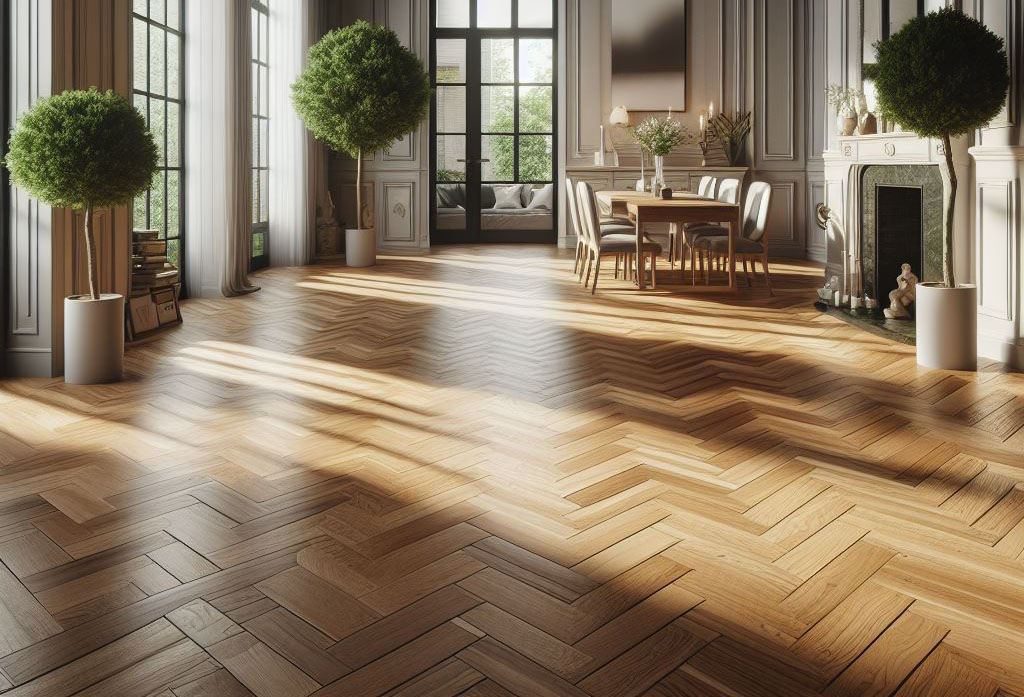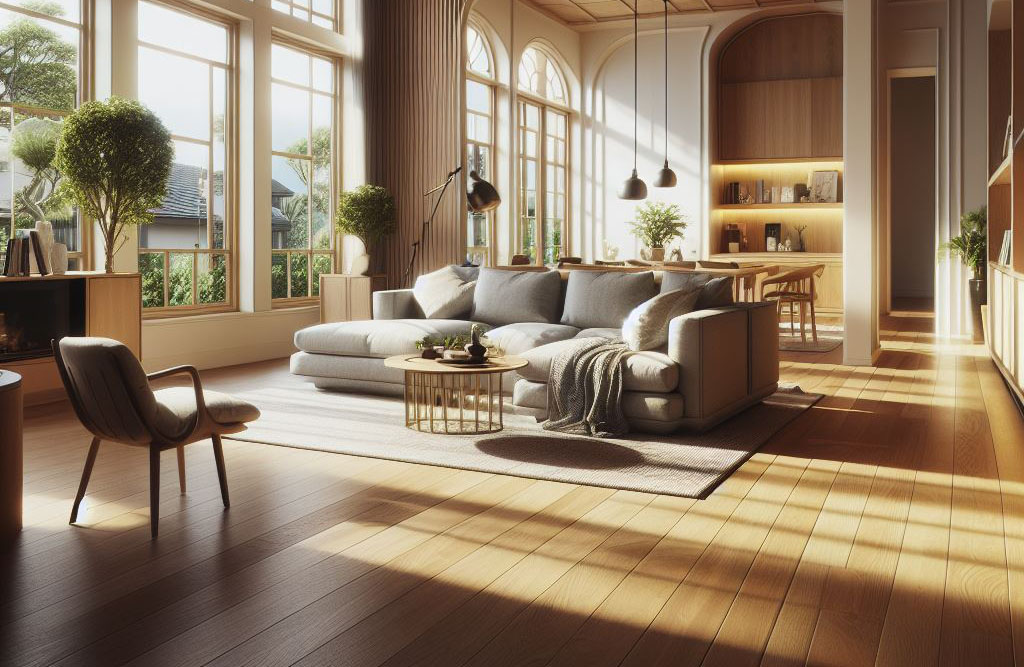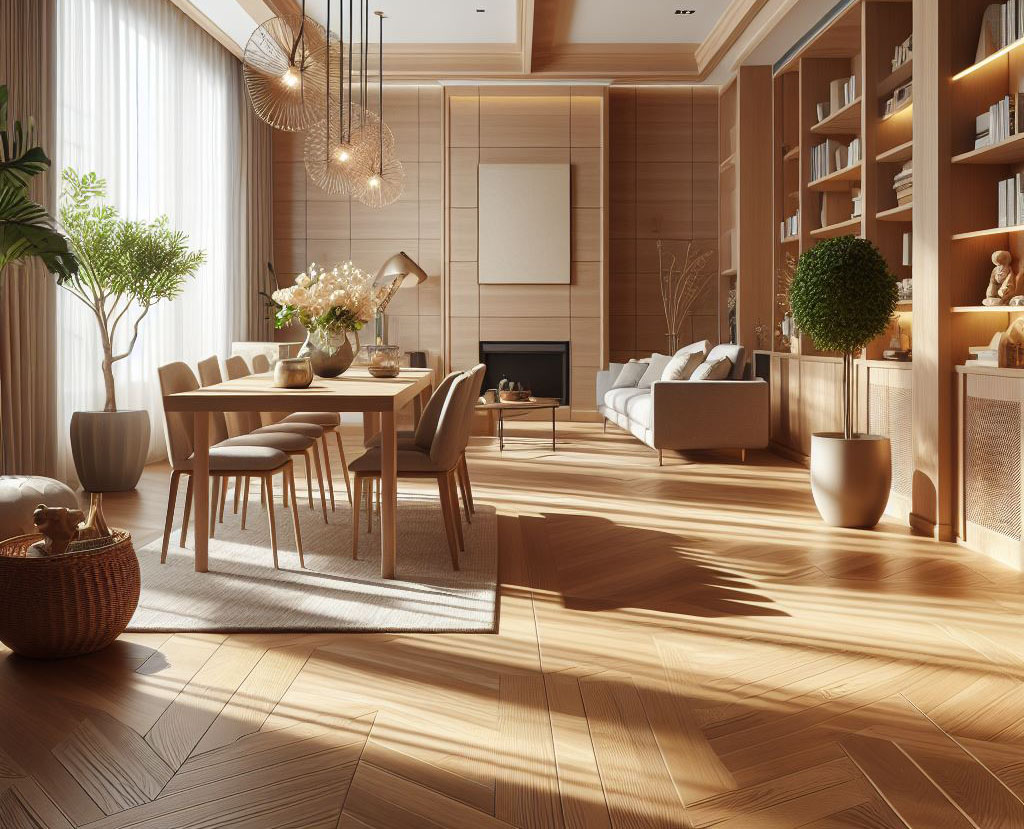Welcome to the world of hardwood flooring, a journey that transforms not just your floors, but the very character of your home. In the realm of home construction and DIY, the choice of hardwood flooring is pivotal. It’s not just a layer underfoot, it’s a decision that shapes the ambiance and longevity of your living space. Regardless of your experience in the trades, understanding the intricacies of hardwood flooring is essential. Let me guide you through this journey, sharing the insights I’ve gleaned from years in the field.

Understanding Hardwood Flooring Basics
Hardwood flooring, the classic choice for elegant and enduring floors, is crafted from solid wood planks derived from various hardwood species. Each type of hardwood brings its own unique qualities and aesthetics.
- Types of Hardwoods: Common choices include oak, known for its resilience and durability, ideal for areas with heavy foot traffic. Maple offers a more subtle grain, perfect for contemporary settings, while cherry wood is renowned for its rich, evolving color palette.
- Advantages: Choosing hardwood isn’t just an aesthetic decision, it’s practical. Hardwood floors are not only durable and easy to maintain but also contribute significantly to the resale value of your home. Their versatility in finishing and styling makes hardwood an ever-popular choice among homeowners.

Factors to Consider When Choosing Hardwood Flooring
Selecting the right hardwood flooring involves a careful consideration of several key factors:
- Durability and Hardness: The foundation of your flooring choice lies in its durability. Measured by the Janka hardness scale, the harder the wood, the better it withstands wear and tear. Oak, for instance, stands as a robust option for bustling home environments.
- Aesthetics and Style: Flooring is a crucial element of your home’s aesthetic. It’s imperative to select a style that complements your home’s overall theme and decor. Whether you’re aiming for a cozy, rustic vibe or a sleek, modern look, your hardwood flooring can significantly influence the atmosphere.
- Wood Types and Colors: Wood comes in a spectrum of colors and types. Lighter woods can create an airy, open feel, while darker woods are synonymous with elegance and depth. Bear in mind, wood is a natural material and its color can change over time, adding to its unique charm.
- Board Widths and Textures: The width and texture of your hardwood planks can dramatically affect the visual dynamics of a room. Wide planks tend to lend a rustic, spacious feel, whereas narrower boards are often associated with a more refined, traditional appearance. Textural choices range from polished, smooth finishes to more rustic, hand-scraped looks.
- Finishes and Stains: Finishes can be pre-applied or done on-site. Pre-finished floors offer convenience and consistency, while site-finished floors allow for a higher degree of customization. Each option has its own set of advantages and considerations.
As we delve deeper into the nuances of hardwood flooring, I’ll share more detailed advice, drawing from real-life scenarios and practical solutions. This guide is crafted to arm you with the knowledge and confidence to select the hardwood flooring that best suits your project, ensuring a choice that you’ll cherish for years to come.
Budgeting for Hardwood Flooring
Let’s delve into the financials of hardwood flooring, a critical step in ensuring that your project stays within the realms of reality and reason.
- Cost Considerations: The spectrum of hardwood flooring costs is as varied as the wood itself. While common hardwoods like oak or maple offer affordability, exotic species like Brazilian cherry command a higher price, both for the material and the installation. It’s essential to balance your desires with your budget, taking into account not just the per-square-foot cost but also additional expenses like underlayments and finishes.
- Long-Term Value: Hardwood flooring should be viewed through the lens of long-term investment. Its durability and timeless appeal can significantly increase your home’s market value. Unlike other flooring options that might need replacement, hardwood floors can be sanded and refinished, extending their life and enhancing their beauty over time. This aspect, often overlooked, plays a crucial role in the overall cost-benefit analysis.
- Installation Costs: The decision between DIY and professional installation is more than just a cost consideration, it’s a balance of skill, time, and quality. While DIY can reduce upfront costs, the expertise and efficiency of professional installers often translate to a flawless finish that stands the test of time. Consider your own skill level and the complexity of your project before deciding which path to take.

Installation Tips for DIY Enthusiasts
For those ready to take on the challenge of installing hardwood floors themselves, here’s a structured approach to ensure a successful outcome.
- Necessary Tools and Materials: A successful installation starts with the right tools. Essential items include a flooring nailer, saws (both table and hand saws are useful), a hammer, tape measure, chalk line, and underlayment material. Each tool plays a pivotal role in ensuring a precise and efficient installation.
- Preparing the subfloor: The foundation of any good flooring job is a well-prepared subfloor. It should be level, dry, and stable. Uneven subfloors can lead to creaking and uneven wear, so take the time to sand or fill as necessary. Moisture testing is critical, excessive moisture can wreak havoc on hardwood floors.
- Installation Techniques:
- Acclimation: Wood is a living material, it expands and contracts with changes in humidity and temperature. Allow your hardwood planks to acclimate to the environment where they will be installed for several days.
- Layout Planning: Before installation, plan the layout of your planks. Consider the visual impact of the plank widths and the placement of joints for both aesthetic and structural integrity.
- First Row Precision: The first row sets the tone for the entire installation. It must be straight and well-secured. An error here can cascade through the entire project.
- Staggering Seams: Staggering the seams as you lay the planks not only adds visual interest but also contributes to the structural strength of the flooring.
- Nailing Technique: A consistent nailing technique ensures that each plank is securely attached while maintaining the necessary expansion gap around the room’s perimeter.
Embarking on a DIY hardwood flooring project is a rewarding venture. With careful planning, attention to detail, and a methodical approach, you can achieve a beautiful and durable floor that reflects your personal touch and craftsmanship.
Maintenance and Upkeep
Maintaining your hardwood floors is crucial for preserving their beauty and extending their life. Here’s how to keep them in top condition:
- Regular Cleaning and Care: The key to longevity is regular maintenance. For everyday cleaning, a soft-bristled broom or a microfiber mop is your best bet. Avoid water and steam, which can damage the wood. In case of spills, a slightly damp cloth should be used for spot cleaning immediately. Area rugs in high-traffic zones not only add style but also protect your floors from wear.
- Repair and Refinishing: When it comes to scratches, minor ones can often be treated with a bit of touch-up using a matching wood stain or a specialized wood marker. For deeper scratches, wood filler followed by sanding and refinishing might be necessary. Refinishing a hardwood floor is a more extensive process, typically involving sanding down to the bare wood and then applying a new finish. This process, though labor-intensive, can significantly revive the appearance of your floor.

Environmental Considerations
In the context of environmental stewardship, choosing the right hardwood flooring is more important than ever.
- Sustainable Sourcing: Opt for hardwood certified by organizations such as the Forest Stewardship Council (FSC), which ensures that the wood is harvested responsibly. Alternatives like bamboo, known for its rapid growth and durability, are also worth considering for their eco-friendly qualities.
- Impact on Indoor Air Quality: The selection of finishes and adhesives is crucial as some products contain volatile organic compounds (VOCs) that can affect indoor air quality. Water-based finishes and natural oil seals are preferable choices for maintaining a healthier indoor environment.
FAQ Section
For areas that see a lot of foot traffic, hardwoods like oak, hickory, or maple are ideal due to their durability and resistance to wear.
Yes, but it requires careful preparation. A moisture barrier and a plywood subfloor are typically necessary, and engineered wood is often a more suitable option than solid wood in these scenarios.
Regular sweeping to remove dirt and grit, using felt pads under furniture, and opting for soft caster wheels can significantly reduce the risk of scratches. Routine maintenance also plays a role in keeping the floors in pristine condition.
Hardwood flooring can coexist with pets, especially if you choose harder woods and finishes that can better withstand potential scratches and scuffs.
This depends on the level of wear and tear, but typically, hardwood floors might need refinishing every 7 to 10 years. Signs that it’s time include visible wear, dullness in high-traffic areas, and an inability to be refreshed through cleaning.
